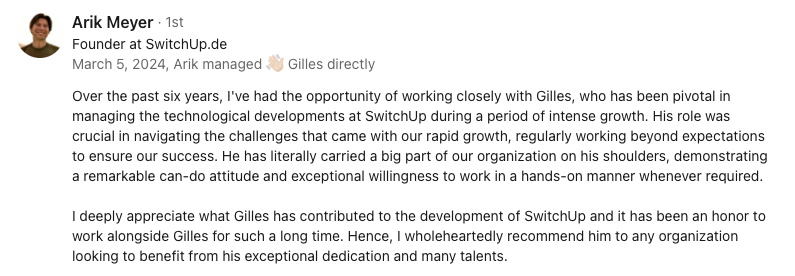Abstract:
The digital age has redefined today’s startups, reshaping business operations and team collaboration due to the global shift towards remote work. Choosing between a tech co-founder and a Chief Technology Officer (CTO) is crucial, as both bring distinct strengths to the table. Startups need to consider the evolving roles of these positions for success. Embracing diversity in leadership, understanding investor expectations, and adapting to emerging business models and technologies are essential for startup growth. For non-technical founders, developing a basic understanding of technology can facilitate better collaboration with technical teams. Navigating international markets requires regulatory compliance, cultural fluency, and technological adaptability. Future tech leadership will likely require a blend of technical expertise, strategic acumen, and ethical guardianship, necessitating continuous learning and adaptability.
Setting the Stage
In the bustling world of startups, the debate between choosing a Tech Co-Founder versus a Chief Technology Officer (CTO) is akin to deciding between espresso and French press coffee for your caffeine fix—both serve the same purpose, but the choice could very well define your morning routine. Understanding the distinctions and impacts of a Tech Co-Founder and a CTO in navigating the complex maze of startup development is crucial. This article aims to clarify these roles, shedding light on their significance and how they influence the trajectory of a startup's journey towards success. Who knew that the right blend of technical leadership could be as essential as your morning brew in steering the ship in the right direction?
Modern Tech Landscape and Startup Dynamics
The technological scene today, much like a finely aged wine, keeps getting more complex and intriguing by the day. Innovations such as Artificial Intelligence (AI), blockchain, and the Internet of Things (IoT) are not just buzzwords but pivotal elements that shape the very fabric of startup success. These advancements demand a tech leadership that is as adaptive as it is visionary. The incorporation of these technologies can significantly enhance a startup's operations, product offerings, and market positioning. But here's the twist—navigating these waters requires a captain with a specific set of technical and strategic skills.
The redefinition of workspaces, with remote work becoming the new norm, adds another layer of complexity to the Tech Co-Founder vs. Chief Technology Officer narrative. Building a startup now often involves orchestrating a symphony with musicians scattered around the globe. This globalization of teams insists on a leadership that's not just tech-savvy but also adept at managing diversity, distributed workforces, and leveraging the strengths of a worldwide talent pool. Hence, the decision between a Tech Co-Founder and a CTO in today's setting is like choosing the right chess piece to make a checkmate move in the complex game of startup chess.
Clarified Definitions and Roles
When it comes to deciphering the roles of a Tech Co-Founder and a Chief Technology Officer, think of it as understanding the difference between salt and pepper. Both are essential on the dining table of a startup's strategy, yet they spice things up in uniquely significant ways.
Tech Co-Founder: The Visionary Architect
A Tech Co-Founder typically enters the scene at the very beginning of a startup’s journey. Imagine a visionary architect dreaming up a grand design. This person is not just a builder but also a part of the startup's DNA, often with a significant stake in the company. They are intrinsically motivated by the startup's mission, equipped to wear multiple hats, and are as comfortable discussing strategy over espresso as they are coding until the wee hours. As the startup grows, the role of a Tech Co-Founder often evolves from being a hands-on developer to a strategic role, focusing on long-term technological vision and innovation.
Chief Technology Officer: The Growth Catalyst
The Chief Technology Officer, on the other hand, might join the fold when the blueprint begins to take shape and the startup needs a seasoned captain to navigate the technical complexities of scaling up. This is a leadership role, focused on operationalizing the company's technological vision, managing the tech team, and ensuring that the technological resources align with the company's growth. The CTO is essentially the growth catalyst, transforming coffee-fueled coding marathons into scalable, robust systems.
To sweeten the pot with real-world flavor, let’s sprinkle in some case studies. Companies like Facebook and Google started with tech-savvy founders who initially took on the roles similar to Tech Co-Founders. As these companies matured, the scope and complexity of their technology strategies necessitated the inclusion of CTOs, dedicated to spearheading technological innovation and scalability while the founders continued to shape the overarching vision and direction. This illustrates a dynamic setup where roles evolve in response to the startup's growth stages, ensuring the right blend of visionary architecture and operational excellence for enduring success.
Consideration for Diversity and Inclusion
Imagine a startup as a gourmet dish. Just as the right blend of spices can elevate the meal, the inclusion of diverse perspectives in leadership roles—such as a Tech Co-Founder or Chief Technology Officer—enriches a startup's culture and fosters innovation. The world has long moved past the cookie-cutter approach in team compositions; today, a mosaic of experiences and ideas is the new norm for driving success and creativity.
Creating an ambiance where differences are not just tolerated but celebrated can lead to more imaginative solutions and a healthier work environment. This is why prioritizing diversity and inclusivity in the selection process for a tech leader or co-founder is not just a moral imperative but a strategic advantage.
Strategies for Building an Inclusive Leadership Team
- Innovative Hiring Practices: Step outside the traditional recruitment playbook. Explore networks and communities that are often underrepresented in the tech field. This approach can uncover hidden gems who bring fresh perspectives to your startup.
- Partnership with Inclusivity Advocates: Collaborating with organizations that promote diversity in tech can provide access to a wide talent pool and resources for supporting an inclusive culture.
- Value-Based Screening: Integrate values of diversity and inclusivity into the DNA of your vetting process. Look for candidates who not only tolerate but embrace and advocate for a varied team composition.
This strategic pursuit for diversity within your startup’s leadership not only colors the fabric of your team with a broad palette but also sets a solid foundation for innovative leaps. After all, a choir where every voice sings the same note might be harmonious, but it's the rich blend of different tones that creates a masterpiece.
The Impact of Funding and Investment Trends
Imagine you're in a high-stakes poker game. In the startup world, the ante is high, and your hand is your tech leadership team. Investors are keen players at this table, and their expectations, along with the current investment climate, can significantly influence whether you're betting on a Tech Co-Founder or a Chief Technology Officer (CTO). With venture capital eyes meticulously scanning for ROI, the choice often boils down to which role can promise innovation and scalability, expeditiously.
Venture studios and accelerators play the equivalent of a seasoned poker coach, shaping leadership decisions with their unique blend of mentorship, resources, and networking opportunities. These entities often have a finger on the pulse of current tech trends and investment appetites, guiding startups toward structures that are more likely to attract attention—and financial backing. Whether suggesting a visionary Tech Co-Founder who mirrors an investor’s enthusiasm for groundbreaking ideas, or advocating for a CTO whose strategic prowess can scale a startup to new heights, the influence of these platforms is undeniable. They are the heralds of informed decisions, steering the startup ship towards prosperous shores under the keen eye of potential investors.
Thus, in the grand casino of startup funding, aligning your tech leadership with investor expectations and funding trends isn't just a savvy move; it's a requisite stride towards securing the jackpot. After all, the art of choosing between a Tech Co-Founder and a CTO might just be the ultimate poker face in the entrepreneurial world.
Broader Range of Startup Stages
Just as a character in a novel grows from one chapter to the next, so does a startup transition through various stages of its journey. This progression can significantly influence whether the badge of tech leadership is worn by a Tech Co-Founder or a Chief Technology Officer (CTO). It's like deciding whether you need a swiss army knife or a specialized tool for the job at hand.
Startup Evolution and Leadership Flexibility
At the outset, startups are often in a fluid state, akin to clay being molded on a potter's wheel. During these early chapters, a Tech Co-Founder, with their broad vision and flexibility, can be invaluable. Their ability to perform a pas de deux between development and strategy is similar to a shapeshifter adapting to various roles as needed. However, as the plot thickens and the business scales, the complexity of its narrative might require a CTO’s specialized touch. This is when the startup needs a maestro, someone who can conduct a growing orchestra of technical challenges and opportunities with finesse.
Pivots and Adaptability: The Plot Twists
Plot twists, such as business pivots and shifts in the model, further season the stew. Adapting to these turns in the tale requires leadership that not only embraces change but thrives on it. A Tech Co-Founder might excel in this dynamic environment, wielding their intimate knowledge of the startup’s core ethos to navigate new waters. Conversely, a CTO's expertise in scaling and systematizing could be crucial in stabilizing the ship post-pivot, ensuring that the new direction is not just a temporary whim but a sustainable trajectory toward success.
So, as your startup writes its own epic saga, consider carefully who you entrust with the helm of technical leadership. The stages of your startup's journey, seasoned with unexpected plot twists, will guide you in choosing the protagonist of your tech narrative. Will it be the versatile Tech Co-Founder or the strategic CTO? Only the chapters yet to be written will tell.
Technical and Non-Technical Skill Balances
Empowering Non-Technical Founders
For non-technical founders venturing into the high seas of the startup world, feeling like a fish out of water when it comes to tech jargon and decision-making is common. But worry not, acquiring a life jacket in the form of tech knowledge is both feasible and wise. Begin by dipping your toes into foundational tech concepts and industry trends; online courses, workshops, and tech meetups can serve as your paddles. Understand the technological needs specific to your startup — you don’t need to learn how to code overnight, but knowing the difference between frontend and backend development can help you make more informed decisions about your leadership team. Whether opting for a Tech Co-Founder or a CTO, equip yourself with enough knowledge to engage in meaningful dialogue and decisions.
Building Bridges Between Teams
Next, let’s turn our attention to the symphony of synergy that needs to play between technical and non-technical team members. Imagine your startup as a band where techies are the instrumentalists, and non-techies handle vocals. The magic happens when everyone’s in tune. Create a culture of mutual learning and respect, where knowledge sharing sessions blend the technical with business acumen. Frame initiatives to ensure that technical milestones are aligned with business objectives, enabling each side to appreciate the other’s challenges and contributions. Encourage tech leaders, be it your Tech Co-Founder or CTO, to develop soft skills like empathy and communication, turning them into conductors who can ensure every section of the orchestra plays harmoniously.
Emerging Business Models and Technologies
Revolutionizing Tech Leadership with SaaS
The recent surge of Software as a Service (SaaS) platforms not only revolutionized how we approach software deployment but has also subtly shifted the sands beneath the feet of tech leadership roles. Like a game of musical chairs, the ever-increasing reliance on SaaS models means the Tech Co-Founder and CTO need to dance to a new tune. The emphasis shifts towards continuous innovation, customer experience, and managing service reliability. This transformative business model demands a technical leader who is not only adept at overseeing these cloud-based services but also possesses a keen eye for detail in ensuring flawless user experiences. The question isn't just about who's more technologically savvy, but who can juggle these SaaS balls with the grace of a seasoned performer.
Surfing the Waves of Technology Trends
In the vast ocean of current technology trends, where waves of AI, machine learning, and blockchain crash against the shoreline of startups, the roles of Tech Co-Founder and CTO need to be surfers par excellence. These leaders must not only ride these waves but also forecast which trends have the momentum to carry the startup forward. The Tech Co-Founder might excel in harnessing these technologies during the early tidal waves of product development, while the CTO becomes crucial when navigating the high seas of scaling and integrating complex systems. This fluid dynamic underscores the importance of a strategic approach to technical leadership, where adaptation and foresight are key paddles in the water.
Practical Guidance on Decision Making
In the grand chess game of establishing a successful tech startup, choosing between a Tech Co-Founder and a CTO can often feel like being stuck between the strategic depth of a queen or the versatile moves of a knight. To navigate this pivotal choice, let's lay out a decision-making map, complete with signposts and guideposts tailored to your startup's unique journey.
Framework for Choosing Your Tech Pathfinder
Firstly, take stock of your startup's current position and desired destination. Is the path riddled with technological innovation that demands a visionary architect? If so, a Tech Co-Founder, with their inherent motivation and broad skill set, might be your sherpa. On the flip side, if your startup's blueprint is already drafted and you're scaling the slopes of growth and complexity, a CTO, the growth catalyst with a knack for operational excellence, could be the seasoned guide you need.
The Compass of Mentorship and Advisory Boards
Let's not forget the compass that is mentorship and advisory boards in this journey. The wisdom of those who have charted similar territories can provide invaluable insight into not just who to choose, but how to integrate your choice effectively into the startup's ecosystem. Advisory boards, with their panoramic view of the startup scape, can offer strategic recommendations tailored to your situation.
- Tech Network Insights: Tap into your network or find a seasoned mentor in the tech industry. Their experiences can provide a mirror to assess your startup's specific needs more clearly.
- Startup Forums and Workshops: Engaging in discussions and sessions focused on startup growth stages and leadership roles can sharpen your decision-making tools, offering fresh perspectives on your dilemma.
Remember, this isn't a one-size-fits-all decision. Like choosing between an espresso and a French press, each option brews a unique flavor of success, shaped by when and how you make your choice. Armed with a robust framework and the seasoned guidance of mentors and advisory boards, steering your startup in the right direction becomes a journey of strategic foresight and informed decisions.
Global Perspective
When your startup is ready to tango on the global stage, choosing between a Tech Co-Founder and a Chief Technology Officer gets spicier than your grandmother’s secret salsa recipe. Operating across borders offers a palette of challenges and opportunities, adding layers of complexity to your recipe for success. Regulatory landscapes shift more than desert sands, and cultural nuances could win or break deals faster than you can say, "global domination."
Navigating International Waters
The quest for international success isn’t just about having a tech wiz who can code with their eyes closed; it’s about understanding the tapestry of global regulations and cultural sensitivities. A Tech Co-Founder might be the globe-trotting pioneer, eager to explore and adapt, weaving the startup’s ethos into different cultural fabrics. On the other hand, a CTO could serve as the astute navigator, charting a course through the regulatory mazes and ensuring the technological fleet is seaworthy and compliant in international waters.
The construction of cross-border technical teams adds another layer of fun to the mix. The right tech leader will not only understand the nuts and bolts of technology but will also be skilled in the art of building bridges—virtual ones, of course—between diverse technical talents scattered across time zones. Whether choosing the rooted versatility of a Tech Co-Founder or the strategic acumen of a CTO, remember, the globe is your playground, but playing requires understanding and respecting its rules. So, lace up your boots (or, in this case, your digital gloves), because going global is the ultimate tech leadership adventure.
Future Outlook
Evolution of Roles: A Glimpse into Tomorrow
Peering into the crystal ball of tech startups, the roles of Tech Co-Founder and Chief Technology Officer are set to dance to an increasingly complex tune. As startups continue to thrive on innovation, these roles might evolve into more hybrid forms, perhaps blending the visionary with the strategic in ways we’re just beginning to imagine. Imagine a future where the Tech Co-Founder and CTO are like two sides of a tech Rubik’s Cube, constantly shifting to adapt to new challenges and opportunities in a seamless display of teamwork and technical acumen.
Ongoing Education: Sharpening Your Blades
- Continuous Learning Platforms: Websites like Coursera, Udemy, and Pluralsight are treasure chests brimming with courses on tech leadership and the latest technological trends. They offer a way to keep your sword sharp in the battle of innovation.
- Tech Leadership Podcasts and Blogs: Subscribing to insightful podcasts such as "Masters of Scale" and blogs penned by visionary leaders in the tech arena can offer both inspiration and practical advice for navigating the stormy seas of startup leadership.
- Networking Groups: Joining groups on platforms like LinkedIn or exclusive clubs for tech leaders can be akin to finding a crew for your startup ship—offering support, knowledge exchange, and perhaps even a map to buried treasure.
As we march forward, the dichotomy between Tech Co-Founder and CTO might blur, blending into a leadership style that is versatile, adaptive, and holistic. Nurturing one’s skills through continuous education and networking will be key to staying afloat and thriving in this exciting journey. So here’s to mastering the art of leadership in the wondrous world of startups, where the only constant is change!
You might be interested by these articles:
- From Engineer to Leader: The Journey of Becoming a CTO
- Navigating the CTO Career Path
- Thriving in Europe's Startup Ecosystem: Turning Challenges into Opportunities





